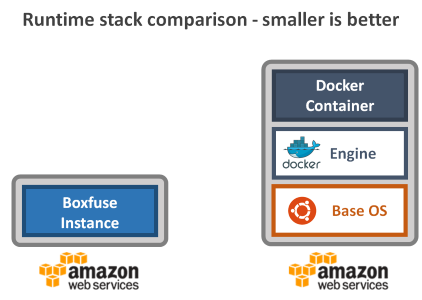
Docker vs CloudCaptain
CloudCaptain is an integrated, fast and much easier alternative to Docker for running JVM and Node.js apps on AWS.
Here's why you should consider switching...
Thinking of making the switch to CloudCaptain to run your JVM and Node.js apps on AWS?
We want to make the decision as easy as possible, so we’ve put together some info that’ll help you decide which option is best for you.
Below, you'll find information to help you compare CloudCaptain and Docker, including features, pricing and thoughts from current CloudCaptain customers who have made the switch.
1. CloudCaptain is much easier to use and better integrated than Docker
CloudCaptain is all about making you productive so you can focus on delighting your customers instead dealing with infrastructure issues. We made sure CloudCaptain is a joy to use by making running JVM and Node.js applications on AWS absolutely trivial. There are no lengthy tool chains to master, no complicated integrations and no tedious OS provisioning and hardening. Instead all you need is a single command, boxfuse run, which will take you all the way from JVM or Node.js application to fully-provisioned AWS infrastructure with no configuration required:
> boxfuse run myapp-1.0.jar Fusing Image for myapp-1.0.jar ... Image fused in 00:06.525s (55362 K) -> myuser/myapp:1.0 Pushing myuser/myapp:1.0 ... Verifying myuser/myapp:1.0 ... Waiting for AWS to create an AMI for myuser/myapp:1.0 in eu-central-1 (this may take up to 50 seconds) ... AMI created in 00:19.777s -> ami-e66264fb Creating Elastic IP ... Mapping myapp-myuser.boxfuse.io to 52.29.173.190 ... Creating security group boxsg-myuser-prod-myapp-1.0 ... Launching t2.micro instance of myuser/myapp:1.0 (ami-e66264fb) in prod (eu-central-1) ... Instance launched in 00:49.422s -> i-d671f06a Waiting for AWS to boot Instance i-d671f06a and Payload to start at https://54.93.73.84:8080/ ... Payload started in 00:55.276s -> https://54.93.73.84:8080/ Remapping Elastic IP 52.29.173.190 to i-d671f06a ... Waiting 15s for AWS to complete Elastic IP Zero Downtime transition ... Deployment completed successfully. myuser/myapp:1.0 is up and running at https://myapp-myuser.boxfuse.io:8080/
CloudCaptain does this by first analysing your application and then that information to automatically generate an image with a minimal Linux-based OS on-the-fly. CloudCaptain then uploads your new image to AWS, converts it to an AMI and provisions all the necessary infrastructure in the region of your choice.
CloudCaptain runs natively on Windows, Mac and Linux and comes with special optimizations for popular tools and frameworks like Spring Boot, Dropwizard, Grails, Play, Executable Jars, Tomcat, TomEE and Node.js.
CloudCaptain goes well beyond what you would expect and is able to read your framework's native configuration files and automatically configures security groups, load balancers and more based on the port and healthcheck information they contain, with no additional effort required on your part (needless to say, you can of course override these defaults should you want to).
2. CloudCaptain images are smaller and deployment is simpler
At CloudCaptain we strongly believe that being able to iterate quickly is a must. And that's why we've built a unique image creation process that produces ultra small images in seconds. See for yourself how the images for the Spring Boot application from our getting started pages compare:

Not only are CloudCaptain images much smaller, but they also contain a bootloader and a kernel so you don't need any additional base operating system, engine or agent to run them:

CloudCaptain images are converted into very small AMIs which tie in natively with all the important native AWS services like ELB health checks, auto-scaling and security groups.
I had an issue with getting http and https to work with Docker. What I have spent the last 2 days trying to get Docker/Play/Beanstalk to play nice together and do, was accomplished by CloudCaptain in 5 minutes. It is nice to finally have a piece of software that does exactly what it says it does, as easily as it says it does it.
Adam Wenzel, Technical Co-Founder, Business Networks Research
3. CloudCaptain is built for Continuous Deployment
Continuous Deployment is critically important for many companies today, allowing them to innovate and iterate faster.
CloudCaptain fully embraces this by treating build tool plugins as first-class citizens, making it effortless to integrate AWS deployment directly into your pipeline. In addition to its command-line client, CloudCaptain comes with both Maven and Gradle plugins which can be readily integrated through the usual means:
Gradle: build.gradle
plugins {
id "com.boxfuse.client" version "1.37.0.2024"
}
Maven: pom.xml
<plugin>
<groupId>com.boxfuse.client</groupId>
<artifactId>boxfuse-maven-plugin</artifactId>
<version>1.37.0.2024</version>
</plugin>
For rapid turnarounds and fast feedback, CloudCaptain also lets you run your images on VirtualBox. This is a great way to run your integration tests locally before deploying to AWS. And unlike Docker, CloudCaptain's client runs natively on Windows, Mac and Linux with no special shell or setup required.
4. CloudCaptain is affordable
We get it, Docker is free.
And free is a great price, especially for small businesses.
But we believe that the value you’ll get from CloudCaptain far outweighs the cost. And our customers agree.
If our zero configuration application deployment features can save your team just 30 minutes per month, then CloudCaptain will more than pay for itself.
Our pricing is simple: your first application is on us and after that plans start at just $25 per month.
5. CloudCaptain is here to help
We're committed to making sure that you have the best experience you possibly can using CloudCaptain.
That's why our customer success team checks in with every single customer to proactively answer any questions you may have.
We're here for you with personal support, all day, every day, via email, GitHub and social media, no matter what you need.
Ready to give CloudCaptain a try?
We hope this comparison guide was useful to you.
Making the switch is easy; you can get set up on CloudCaptain in just a few minutes.
To sign up for your free, no-risk trial (no credit card required), just click here.
Still have questions? Simply send us an email at hello@cloudcaptain.sh.
We hope to see you in CloudCaptain.
